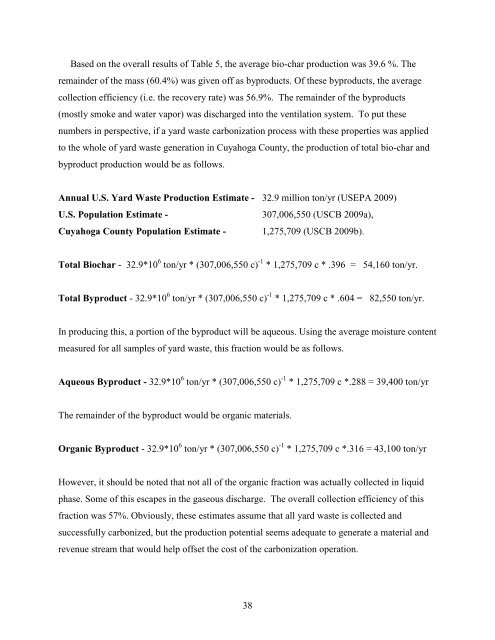Final Report - Ohio Department of Transportation
Final Report - Ohio Department of Transportation
Final Report - Ohio Department of Transportation
Create successful ePaper yourself
Turn your PDF publications into a flip-book with our unique Google optimized e-Paper software.
Based on the overall results <strong>of</strong> Table 5, the average bio-char production was 39.6 %. The<br />
remainder <strong>of</strong> the mass (60.4%) was given <strong>of</strong>f as byproducts. Of these byproducts, the average<br />
collection efficiency (i.e. the recovery rate) was 56.9%. The remainder <strong>of</strong> the byproducts<br />
(mostly smoke and water vapor) was discharged into the ventilation system. To put these<br />
numbers in perspective, if a yard waste carbonization process with these properties was applied<br />
to the whole <strong>of</strong> yard waste generation in Cuyahoga County, the production <strong>of</strong> total bio-char and<br />
byproduct production would be as follows.<br />
Annual U.S. Yard Waste Production Estimate - 32.9 million ton/yr (USEPA 2009)<br />
U.S. Population Estimate - 307,006,550 (USCB 2009a),<br />
Cuyahoga County Population Estimate - 1,275,709 (USCB 2009b).<br />
Total Biochar - 32.9*10 6 ton/yr * (307,006,550 c) -1 * 1,275,709 c * .396 = 54,160 ton/yr.<br />
Total Byproduct - 32.9*10 6 ton/yr * (307,006,550 c) -1 * 1,275,709 c * .604 = 82,550 ton/yr.<br />
In producing this, a portion <strong>of</strong> the byproduct will be aqueous. Using the average moisture content<br />
measured for all samples <strong>of</strong> yard waste, this fraction would be as follows.<br />
Aqueous Byproduct - 32.9*10 6 ton/yr * (307,006,550 c) -1 * 1,275,709 c *.288 = 39,400 ton/yr<br />
The remainder <strong>of</strong> the byproduct would be organic materials.<br />
Organic Byproduct - 32.9*10 6 ton/yr * (307,006,550 c) -1 * 1,275,709 c *.316 = 43,100 ton/yr<br />
However, it should be noted that not all <strong>of</strong> the organic fraction was actually collected in liquid<br />
phase. Some <strong>of</strong> this escapes in the gaseous discharge. The overall collection efficiency <strong>of</strong> this<br />
fraction was 57%. Obviously, these estimates assume that all yard waste is collected and<br />
successfully carbonized, but the production potential seems adequate to generate a material and<br />
revenue stream that would help <strong>of</strong>fset the cost <strong>of</strong> the carbonization operation.<br />
38
















